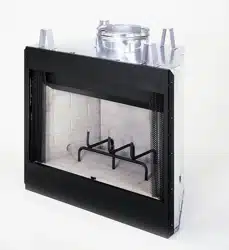Loading ...
Loading ...
Loading ...

SuperiorFireplaces.us.com127003-01_C 11
APPENDIX A Continued
See Chimney Guidelines to assist you in
selecting the proper venting system for
your installation.
American National Standards Institute
ANSI/NFPA 211, Standard for Chimneys,
Fireplaces, Vents, and Solid Fuel-Burn-
ing Appliances - See Draft Section: A
chimney or vent shall be so designed and
constructed to develop a flow sufficient to
completely remove all flue and vent gases to
the outside atmosphere. The venting system
shall satisfy the draft requirements of the
connected appliance in accordance with the
manufacturer’s instructions.
Chimney Guidelines:
• Most wood-burning appliances re-
quires approximately 12 feet mini-
mum of “effective draw” provided
by the venting system. As a rule of
thumb, every 90 degree total direc-
tion change in the venting will result
in a loss of approximately 5 feet of
“effective draw.” Example: If two 45
degree offsets are used, subtract 5
feet from the actual vertical vent height
to determine your “effective draw.” In
this case if you had 14 feet of vertical
vent, the effective draw would only be
approximately 9 feet (14 ft. - 5 ft. = 9
ft.), therefore it may be necessary to
add additional height to the venting
system.
• Do not install an offset within the first
two feet above the flue outlet on the
appliance.
• In well insulated and weather tight
homes, it may be difficult to establish a
good draft up your chimney. The poor
draft is caused by a shortage of air in
the house. In this situation an Outside
Air Kit may need to be installed (See
Negative Pressure Warning below and
Outside Combustion Air in the Instal-
lation and Operation manual).
Negative Pressure Warning
These appliances are not designed to be
operated in a negative pressure. In very
airtight homes with large kitchen exhaust
fans, furnace cold air returns, fresh air
exchange systems and any other air
system in close proximity to the heating
appliance may create a negative pressure
in the same room as the heating appliance.
This can create dangerous back drafting of
the appliance and chimney joints, drawing
combustion by-products into the home. Be
sure your home has adequate makeup air
to eliminate negative pressures caused by
the above-mentioned sources. Outside air
connected to the appliance probably will
not resolve such a problem as the appliance
is not the source of negative pressure. IHP
accepts no liability for damages resulting
from negative pressures described here.
Ventilation Requirements - Provide
adequate air for combustion. The fresh
air requirements of this appliance must
be met within the space where it will be
installed. Ventilation is essential when
using a solid-fuel-burning appliance. In
well insulated and weather tight homes, it
may be difficult to establish a good draft
up the chimney (caused by a shortage of
air in the home). The lack of air is caused
by many common household appliances
which exhaust air from the home (such
as a furnace, heat pump, air conditioner,
clothes dryer, exhaust fans, fireplaces,
and other fuel burning appliances). Also,
the combustion process of this appliance
uses oxygen from inside the dwelling. If the
available fresh air delivery in the dwelling
is insufficient to support the demands of
these appliances, problems can result (i.e.
excessive negative pressure can develop
in the dwelling which will affect the rate at
which this appliance can draft thus result-
ing in performance problems or smoking.
To correct this problem it may help to open
a window (preferably on the windward side
of the house) or install an outside air kit.
Loading ...
Loading ...
Loading ...
